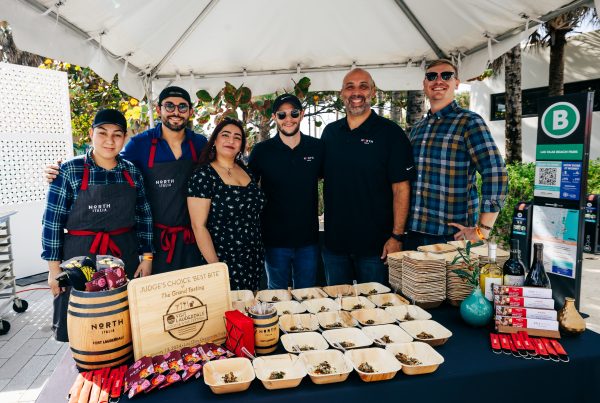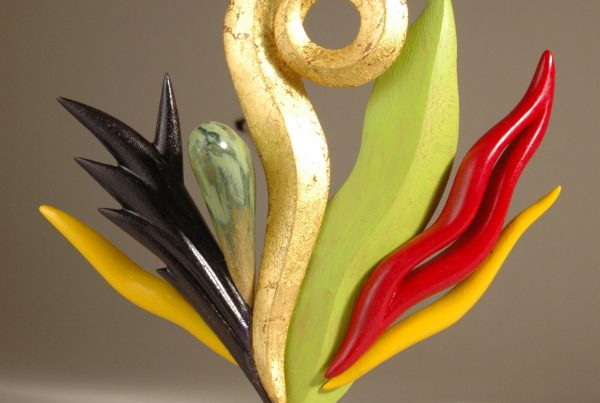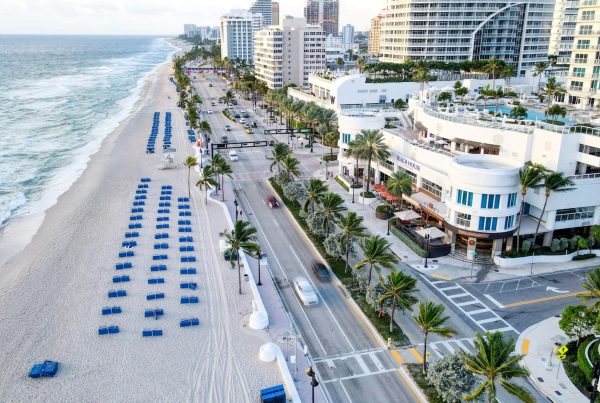Few issues are more pressing to Floridians than climate change, many of whose disastrous effects have already manifested on our coastal areas. And with artists often serving as a culture’s moral and ethical compass, it’s no surprise that many of Palm Beach County’s painters, sculptors, photographers and mixed-media creatives have found novel ways to address this urgent topic—each of them, in a way, acting locally and thinking globally.
“Visualizing Climate Disruption,” which opens today at the Cultural Council for Palm Beach County’s main gallery in downtown Lake Worth Beach, amasses 15 such artists who live and work throughout the Palm Beaches. Curated by the Council’s Jessica Ransom, the work spans from humorous commentary to stark catalogues of destruction to elegies for what has already been lost.

In the latter category, the installation “Flight Patterns: Two Degrees Celsius” (pictured above) from Autumn Kioti, is perhaps my favorite work in the exhibition. It compiles Audubon-style ornithological ink prints mounted under glass and suspended in midair. But in Kioti’s modification, the bird species identified in the images (mangrove cuckoo, blue warbler, etc.) have been removed, leaving bird-shaped vacancies. It’s a deceptively simple yet profound statement: Their absence speaks volumes about the increasing endangerment and extinction of Florida’s migratory bird population.
In painter Gisela Pferdekamper’s “It’s All About Balance,” the animal kingdom is presented as a pyramidal house of cards that’s rich in subtle details—like the way the claws of a toucan extend from the flatness of the playing card to perch on an inviting human hand. But the overarching message, I feel, is sorrowful. We are not the protector in this situation but the destroyer. This fragile construction is one that can be toppled at any moment by the caprices and infringements of humans.

Elsewhere, beauty and destruction commingle in the smoldering oils of Elaine Weber, who contributed a suite of photos inspired by ferocious wildfires and the first-responders tasked with putting them out. Abstract and figural imagery roils together amid indescribable blends of oranges and reds, a collective testament to nature’s unchecked fury.
Three selections from Ron Garrett inspire a similar sense of awe at Gaia’s reaction to anthropogenic climate disruption. Mixing media with salvaged objects, his staggering “Aftermath” assesses the carnage left by a superstorm. A futile 3D life preserver catches the eye first, and below it, canoes, small ships and other vessels rest in a post-apocalyptic harbor, buried and splintering amid tangles of branches and rope. If Robert Rauschenberg were still alive and made activist art, it might look something this like. “Aftermath” hangs next to Garrett’s more uncluttered, but perhaps even more dangerous, “Spillway,” in which an oil tanker’s toxic cargo tumbles into the water like colorful Lego blocks—an almost pretty, childlike aerial vista juxtaposed against the work’s hazardous implications.

Not all of the artists “set” their works in South Florida, or even the southern United States. In Tiffany Beasi’s painting “Reflected Chaos,” swirling spirals of blue and green capture an Arctic in flux, while its central distorted figure of a polar bear melts, tragically, into the morass. Jaime Rodriguez’s nearby installation, “Ice Breaks,” meanwhile, best utilizes sardonic humor amid the pathos. It’s a still-life depicting a rubble of melting ice and the animals—a fox, a gull, a tiny chipmunk frozen in amber—marooned by its destruction. At the top, an ironic, gilt-framed painting of a lovely seascape has survived the carnage.
And at the end—literally, they are the final works mounted in the exhibition—are the award-winning nature paintings of Carin Wagner. Part of her “Vulnerable and Vanishing” series on critically endangered trees, the paintings are the thematic flipside of Kioti’s requiem for disappearing birds. Inspired by writings on the sentience of trees from the likes of Ralph Waldo Emerson and James Lovelock, Wagner takes the opposite approach of Kioti to achieve the same means. Her botanical oil paintings are so photorealistic, down to every venule on a leaf and every piece of bark on a trunk, that they inspire a tactile sense of communion with nature. You can practically smell the forest in each of them. It’s enough to turn every Hummer driver into a tree-hugger—newly and mournfully aware of what we’re on the verge of losing.
“Visualizing Climate Disruption” runs through April 8 at the Cultural Council for Palm Beach County, 601 Lake Ave., Lake Worth Beach. Admission is free, and gallery hours are noon to 5 p.m. Tuesday to Saturday. Call 561/471-2901 or visit palmbeachculture.com.
For more of Boca magazine’s arts and entertainment coverage, click here.







